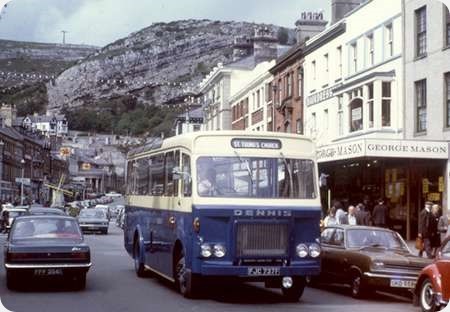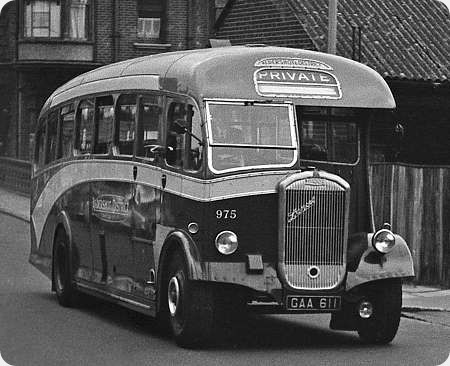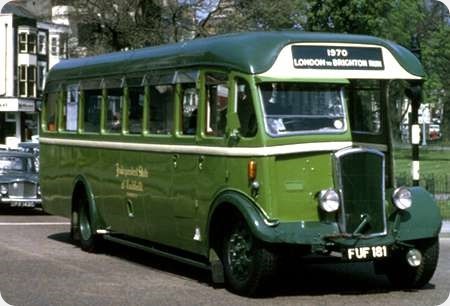Llandudno UDC – Dennis Pax V – FJC 737F
Llandudno UDC
1968
Dennis Pax V
Dennis B33F
In the latter months of 1968 Llandudno UDC replaced its two Foden PVSC6 coaches, www.old-bus-photos.co.uk/ used on the exceedingly steep Great Orme route, with two specially constructed Dennis Pax V buses with Dennis B33F bodywork, registered FJC 736/7F. After the delivery of the last five production Lolines to Halifax in 1967 Dennis had effectively abandoned the bespoke passenger vehicle market, and these were flat framed haulage chassis powered by Perkins 6.354 engines coupled to Dennis U type gearboxes (not, as suggested elsewhere on the internet, David Brown gearboxes). The specially constructed bus bodies, the very last built by Dennis, were delivered in a new livery of blue and cream. The Perkins 6.354 was ever a raucous power unit (I write from experience) and the din inside these buses during the steepest sections of the ascent of the Great Orme must surely have been deafening for drivers and passengers alike, though the standard of ride is said to have been good. Does any OBP aficionado have personal experience of these machines? The photograph was taken in September 1970. On 1st April 1974 Llandudno UDC was subsumed into the new Aberconwy District Council and the two Dennis Pax buses were repainted into a livery of maroon and grey, subsequently maroon and cream. Sadly, FJC 737F was later destroyed, reputably by fire, but FJC 736F survives in a restored condition.
Photograph and Copy contributed by Roger Cox
11/08/22 – 05:52
I may have been partly responsible for spreading the idea that these Dennises had David Brown gearboxes. The information came from Nick Larkin, one-time owner of FJC 736F, when he loaned it to a group of enthusiasts in Chesterfield. As a passenger I believed him, because not only was the arrangement of the gears the same as on the David Brown gearbox of the Bristol SC, but it even exhibited the same characteristic of catching out the unwary driver by moving off in reverse instead of second, which I have heard a Bristol SC owner talk about. It scaled Slack Hill in second gear, and almost repeated the achievement at Cromford, only resorting to first at the very top, after turning into Porter Lane. I can’t say I noticed the noise level inside, but those waiting with cameras outside certainly did! As to liveries, the first Aberconwy DC scheme I would describe as vermilion and grey rather than maroon and grey, and I haven’t seen in-service photos of anything later except blue and advertising schemes. I have been assuming that the new owner’s pseudo Llandudno UDC maroon and cream is a ‘should have been’ statement.
Peter Williamson
12/08/22 – 05:55
Peter W, you’ve just confirmed my recollection of this vehicle, I felt sure I’d had a ride on it and it was at one of Transpire’s Running Days in Chesterfield about ten years ago. I would agree that it was somewhat noisy inside but not unbearably so. I also remember the gearstick being behind the driver to his left, in the same manner as a Bedford SB. It was an interesting ride but I couldn’t help thinking it wasn’t really meant to be a bus though!
Chris Barker
14/08/22 – 05:43
I have driven Bristol SC and SU buses, both of which had the David Brown gearbox, but the gear lever selection positions of the two types differed. On both, the reverse and first gears were located on the far left, forward for reverse, back for first, and these gears were ‘protected’ from the rest of the box by a detente spring that became very weak over time. From there, cautiously moving right in neutral, next came forward for second and back for third, which is how the accidental engagement of reverse instead of second sometimes occurred when the detente spring had weakened. The SCs and SUs that I drove were all secondhand examples run by an independent operator, consequently far from pristine in condition. My technique to avoid the unintended launch in reverse was to deliberately engage reverse on the far left of the box, then carefully go back into neutral and let the stick gently move with the spring to the correct point to allow the forward engagement of second. This took less time to do that it does to describe. Even then I would cautiously engage the clutch to ensure the vehicle was going where I wanted it to go. After the third gear position the SC and the SU differed. To move from third to fourth in the SC one took the stick forward into neutral, over to the right and then back again in an inverted U movement, and then fifth was fully forward from that slot. The SU was more logical, and followed the positioning of the AEC Reliance five speed box, over and forward for fourth and back for fifth. Unsurprisingly, I have never driven a Dennis Pax, but the excellent gearbox in the Dennis Loline III also followed the Reliance selection format, and never once driving these for Aldershot and District did I accidentally engage reverse instead of second. Descriptions of the U type five speed gearbox show that it emulated the Loline box in gear stick positions, which explains the possibility of starting off in reverse, but Dennis gearboxes were fine pieces of engineering, and I can only assume that the protective detente spring in FJC 736F has suffered severely over time. Incidentally, one could never fall into this trap with a Reliance because the gear lever had to be lifted over a ramp to engage first and reverse, so you couldn’t easily get first whilst on the move – it was essentially a crawler gear. On the livery question, is the maroon and cream of the little Guy Wolf accurate?
Roger Cox
15/08/22 – 06:41
The gear positions on FJC 736F were definitely the same as on the SC, complete with inverted U from 3 to 4. Our driver only forgot once, going straight from 3 to 5 and then quickly correcting. So maybe it has been fitted with a David Brown box at some time on its travels.
Peter Williamson
17/08/22 – 06:30
My apologies, Peter. That, as you describe it, is the David Brown gearbox as fitted to the Bristol SC, which is somewhat puzzling. The SC was produced from 1954 to 1961, and its successor, the SU with improved gear selection, from 1960 to 1966. Why would a mere two bus bodied examples of a widely sold Dennis haulage chassis, with a proven drive train of Perkins 6.354 engine and Dennis U type gearbox, appear late in 1968 with an old 1961 type of David Brown box? Surely these two machines didn’t emerge from Guildford in that form. Quite apart from assessing the dubious mechanical benefit of the David Brown box, the re-engineering would have simply increased costs to no discernible advantage – quite the opposite in my view. As far as I am aware, the only alternative gearbox offered by Dennis around that time was the Turner synchromesh. This seemingly straightforward post on the Llandudno Dennis Pax buses has taken a curious turn. Can anyone add to this aspect of the history of these vehicles?
Roger Cox
18/08/22 – 06:42
I remember the two Dennis taking over the Great Orme service from the Fodens but I don’t recall travelling on the Dennis but made several trips over the years on each of the Fodens. The Fodens were fitted with a sprag brake, effectively a ratchet which dropped into a pawl on the transmission when activated by the driver. This was used on the upward journey where the very steep 1 in 4 started just below a terrace of houses and remained in use until about the Half Way station for the tram. This was to prevent a runaway in the event of the engine stalling. Does anyone know if the Dennis pair had this device?
Ian Wild
Quick links to the - Comments Page - Contact Page - Home Page



